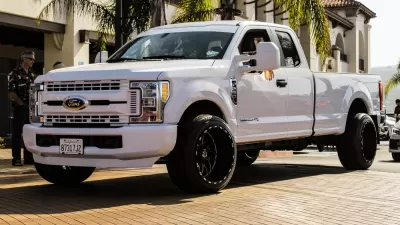Both are problems, but globally, sports utility vehicles sales are proliferating far faster than cars, be they electric or petrol-powered, posing a major challenge for governments committed to reducing greenhouse gas emissions.

"The global S.U.V. boom is a roadblock in the march toward cleaner cars...," reports Hiroko Tabuchi for The New York Times on March 3. According to John German of the International Council on Clean Transportation, "[t]he fuel economy/GHG targets for light trucks [in the U.S.] are more than 25% lower than the targets for cars with the same footprint (wheelbase times track width)..."
Spurred by rising incomes and lower gas prices, drivers in China, Australia and other countries are ditching their smaller sedans for bigger rides at a rapid pace. For the first time, S.U.V.s and their lighter, more carlike cousins known as “crossovers” made up more than one in three cars sold globally last year, almost tripling their share from just a decade ago, according to new figures from the auto research firm JATO Dynamics.
McKinsey, the global consulting firm, predicts that by 2022, one in every two cars sold in China will be an S.U.V.
In the U.S, where car companies created the SUV in the 1970s, light trucks, a category which includes pickups, SUVs, and vans, outsell cars. In 2016, they composed 61 percent of auto sales. Last year, the figure jumped to 67 percent, according to Todd Lassa of Automobile (magazine).
The result is that fuel economy gains slowed to 1.1 percent in 2015, according to the latest data available from the United Nations’ Global Fuel Economy Initiative, "far below the near 3-percent clip needed to simply stabilize emissions from the world’s car fleet," notes Tabuchi. And don't expect battery technology to help in the SUV arena, as lackluster sales of the Tesla Model X would seem to illustrate.
S.U.V.s are also less likely to go electric soon. There are technological hurdles to powering a larger car with batteries, and the perception among many automakers remains that drivers of S.U.V.s value power and performance, and don’t want to be constrained by the range anxiety of battery-powered cars.
While global automakers now investing at least $90 billion in electric vehicle technology, "with ambitious plans to roll out [127] new battery-powered models in the next five years," according to Keith Naughton of Bloomberg News. But the real profits are with light trucks.
"A $60,000 truck, for example, can generate tens of thousands of dollars in operating profit," writes Tabuchi. On the other hands, many manufacturers can expect "to lose between $7,000 to more than $10,000 per electric vehicle sold in the United States," according to Moody's. However, some analysts expect EVs sales to dramatically increase by 2030 if not earlier.
If the outlook for passenger vehicle sales looks bad from a climate perspective, it may go from bad to worse.
One question that worries experts: Will the world embrace the S.U.V.’s even-more-polluting cousin, the all-American pickup truck?
Hat tip to Kenyon Karl
FULL STORY: The World Is Embracing S.U.V.s. That’s Bad News for the Climate

Alabama: Trump Terminates Settlements for Black Communities Harmed By Raw Sewage
Trump deemed the landmark civil rights agreement “illegal DEI and environmental justice policy.”

Study: Maui’s Plan to Convert Vacation Rentals to Long-Term Housing Could Cause Nearly $1 Billion Economic Loss
The plan would reduce visitor accommodation by 25% resulting in 1,900 jobs lost.

Planetizen Federal Action Tracker
A weekly monitor of how Trump’s orders and actions are impacting planners and planning in America.

Wind Energy on the Rise Despite Federal Policy Reversal
The Trump administration is revoking federal support for renewable energy, but demand for new projects continues unabated.

Passengers Flock to Caltrain After Electrification
The new electric trains are running faster and more reliably, leading to strong ridership growth on the Bay Area rail system.

Texas Churches Rally Behind ‘Yes in God’s Back Yard’ Legislation
Religious leaders want the state to reduce zoning regulations to streamline leasing church-owned land to housing developers.
Urban Design for Planners 1: Software Tools
This six-course series explores essential urban design concepts using open source software and equips planners with the tools they need to participate fully in the urban design process.
Planning for Universal Design
Learn the tools for implementing Universal Design in planning regulations.
Caltrans
Smith Gee Studio
Institute for Housing and Urban Development Studies (IHS)
City of Grandview
Harvard GSD Executive Education
Toledo-Lucas County Plan Commissions
Salt Lake City
NYU Wagner Graduate School of Public Service





























